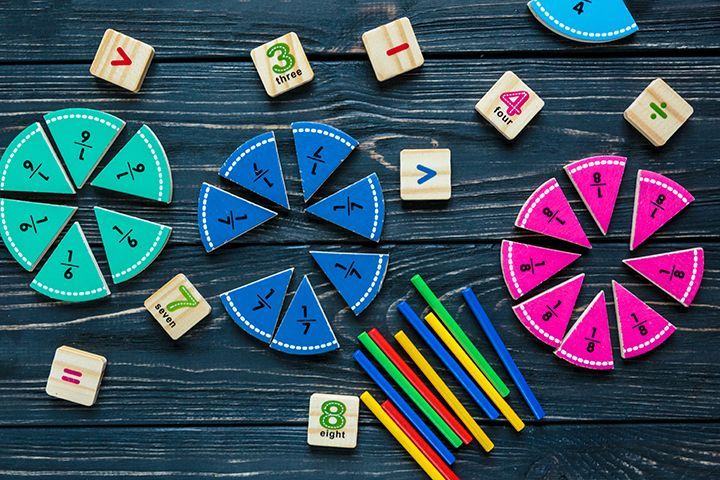What elementary instruction misses about fractions
by Angela McIver, PhD
As I was meeting with my team this morning to refine our unit on fractions, we discussed how even the brightest students become confused about fractions over time.

Studies have shown that students make little progress in their understanding of fractions between 4th and 6th grade (when fractions are first introduced and then expected to be mastered). This may be the result of the unintended consequences of well-meaning instruction.
Below are 3 very common ways students develop misunderstanding of fractions because of the way fractions are taught in elementary schools.
Misconception #1
The larger the denominator, the smaller the fraction
This is probably the most common misconception students develop when it comes to fractions. Although the statement is partially true, it only relates to unit fractions (fractions where all the numerators are 1). We call this pizza/pie thinking because teachers often resort to a pizza or a pie to explain this concept, usually with accompanying drawings. I often hear teachers say “Think of a pizza. Would you rather have a piece of a pizza cut into four slices (¼ of a pizza) or 8 slices (⅛ of a pizza)?” Once students latch on to this way of thinking, they apply it to every type of fraction regardless of the numerator. This thinking can be demonstrated in this video of a high school student when asked to order four fractions based on their relative size. To counter this type of thinking, it is important for teachers to make explicit connections between comparing unit fractions with all other fractions.
Misconception #2
Fractions exist on the workbook page (but not in real life)
A fraction is a tool used to describe problems, situations and phenomena that exist in real life. But most students leave elementary school with a belief that a fraction is a problem that exists on the page of a workbook or computer screen. And, our inability to connect the learning of fractions to real world scenarios is hampering student understanding. I believe this is directly tied to many elementary teachers’ fear of math when veering too far off the page (or computer screen) can expose their own fragile understanding. In this article about student math understanding after the pandemic, a group of teachers learn of how one teacher with math anxiety often skips math concepts to leave for her students’ teachers the following year and others agree. If this happens two or three times in a student’s time in elementary school, it can have an enormous impact on their ability to transfer understanding from the page to “real life.” As math concepts become more complex in the upper elementary grades, teachers tend to stay close to the textbook, unintentionally denying students the opportunity to develop a deep and flexible understanding of fractions.
Misconception #3
A Fraction is a fraction, a decimal is a decimal and a whole number is a whole number
Because whole numbers, fractions and decimals (as well as percents) are often taught in separate units with separate practice problems, students can leave elementary school believing that these are completely separate concepts. Instead, students should build on the understanding that all whole numbers can be written as fractions or decimals (although not all decimals can be represented as fractions - these are irrational numbers). Care should be taken to make sure students develop the fluency to move between these different representations.
Understanding the ways that misunderstanding can develop in students’ thinking can help teachers become more confident and competent teachers in their classrooms. Supporting the deepening understanding of fractions among teachers may help address these gaps.

As a former middle school math teacher, one of my biggest challenges was teaching pre-algebra to students who had not developed automatic recall of basic facts. The students who struggled most in my classes were those who could not quickly do math in their heads. Most elementary schools do a poor job of developing this skill.

It’s been more than a year since U.S. schools closed and children were relegated to remote learning from their bedrooms and kitchen tables. And, while much attention has been given to what students have lost, little attention is given to what has been gained. If there is one thing the pandemic has taught us, it’s that education models can no longer be based on a one-size-fits all approach. As educators move to re-open schools, School Boards across the country must use what they’ve learned to encourage Districts to reimagine schooling for every student.

The new year started off with such optimism. . . At math club we had commissioned a new Mathemagic play to be debuted in March. We were excited about the Spring Monstermathathon and had solidified our plans for summer camp. But, two seismic events turned everything upside down and forced us to change direction, resulting in the decision to close Trapezium Math Club ... and then to re-open it!

I often ask these students to describe what’s going on in their head when they are struggling with a math problem. I interview students who struggle in math. The students I interview range in age from elementary and middle school to adult learners in job training programs. I give students simple elementary math problems and ask them to explain how they would solve them. While these interviews have fundamentally changed the way I think about how we should teach math to struggling students, my biggest “aha” moment didn’t come from the interviews, but from a day of volunteering in my youngest daughter’s kindergarten class many years ago.






